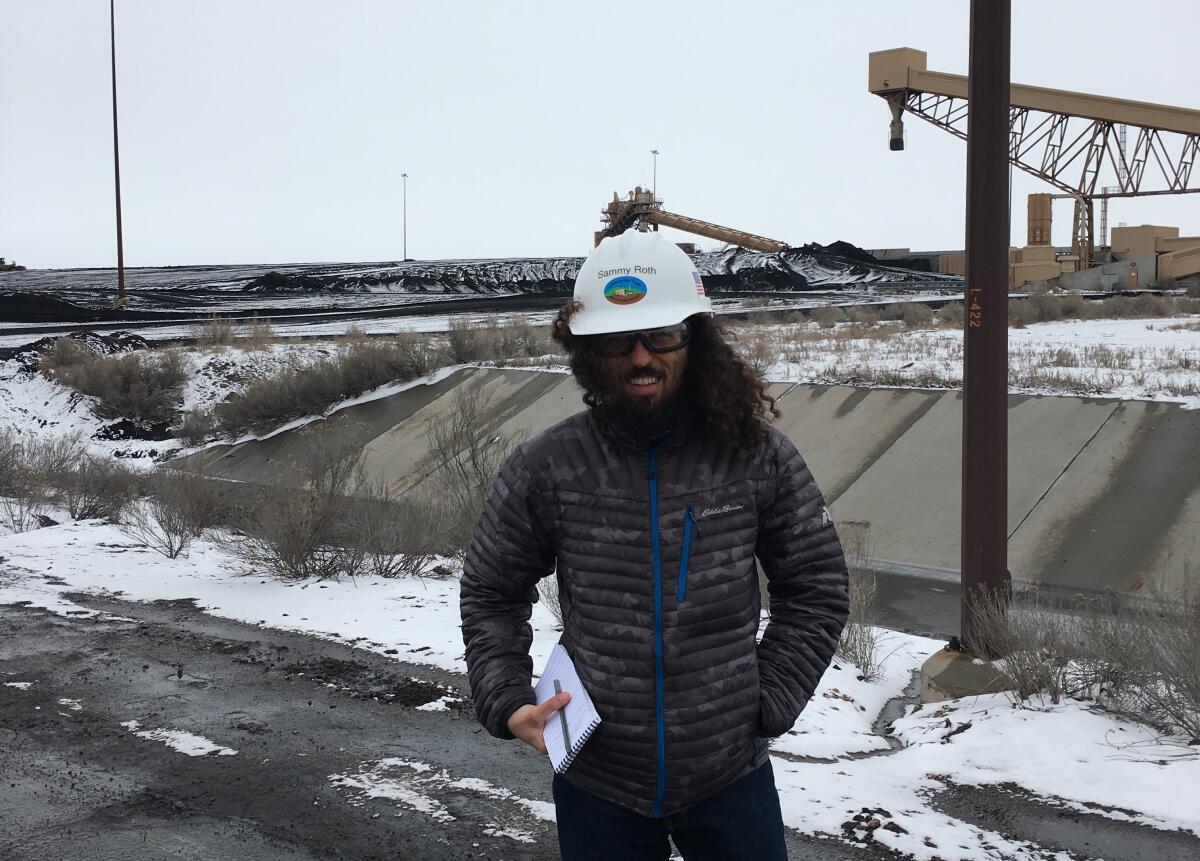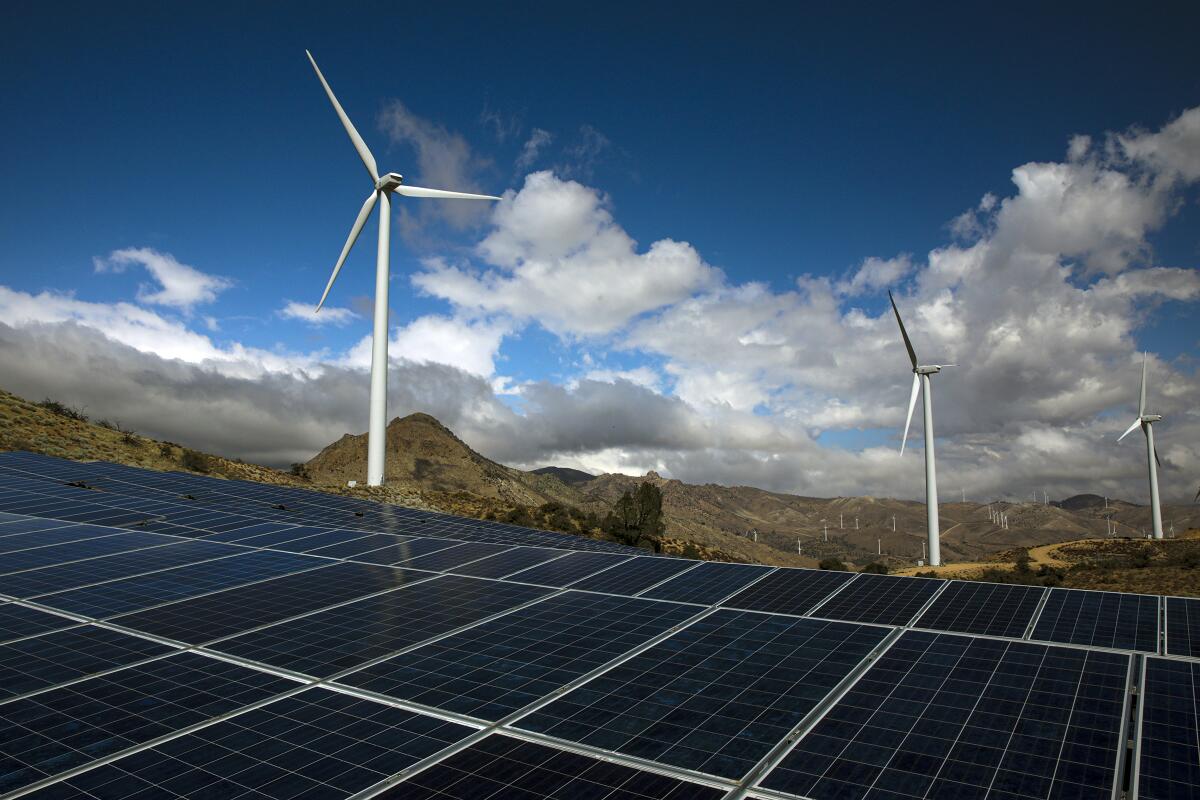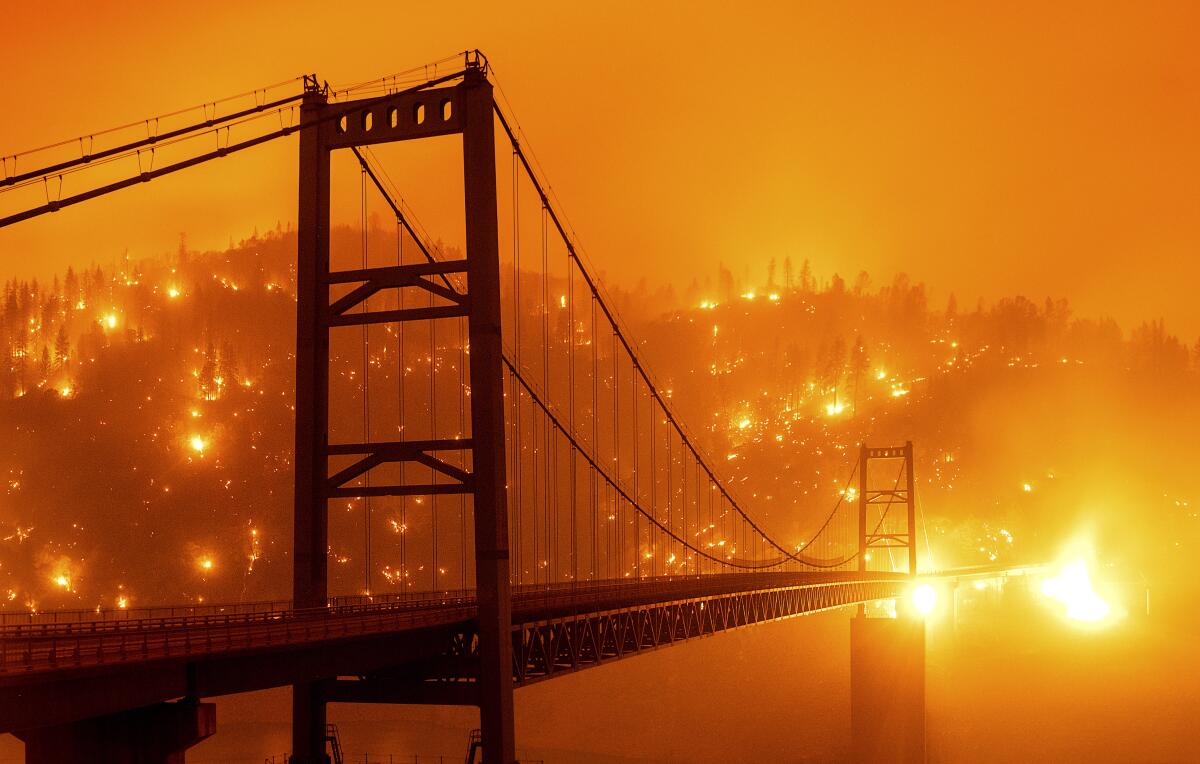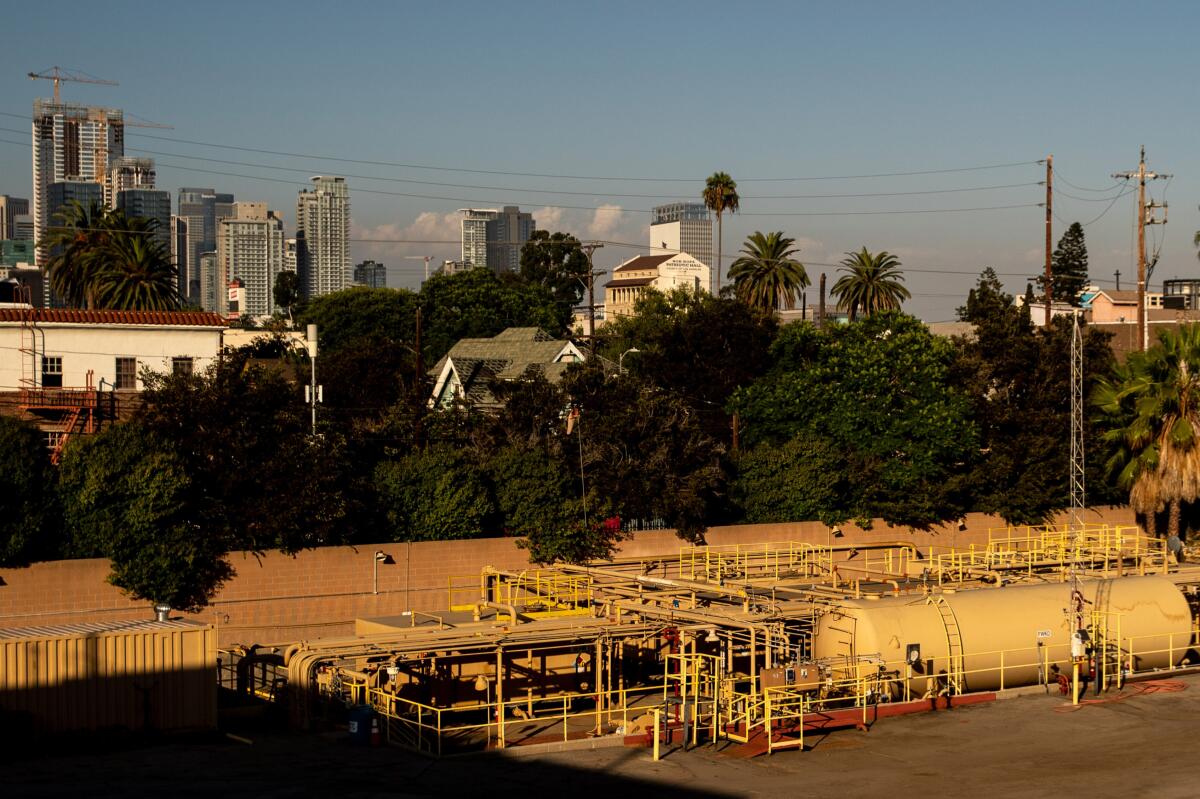Getting personal about climate change made me a better reporter

- Share via
This is the Feb. 3, 2022, edition of Boiling Point, a weekly newsletter about climate change and the environment in California and the American West. Sign up here to get it in your inbox. This week’s edition is being co-published with Covering Climate Now and Columbia Journalism Review.
The third weekend of August 2020 was a hectic time for California.
Wildfires raged, smoke filled the air, and power shortages had forced state officials to order rolling blackouts, meaning hundreds of thousands of homes lacked air conditioning during a brutal heat wave. That Monday, I scrambled to cover the fallout, writing about one state agency blaming another for the power shortfall. The next day, I hurried to report a piece on clean energy technologies that could help California keep the lights on, hoping to offer solutions during a bleak moment.
By Wednesday, I was mentally and physically exhausted. So I wrote about that, too.
In that week’s edition of Boiling Point, I discussed climate despair and my strategies for coping with it, in hopes that readers feeling similarly fatalistic would find it useful. I described what it was like for me personally living through those hellish few days, and offered some Jewish wisdom from an ancient rabbi that had helped me keep perspective: “It is not your responsibility to finish the work of perfecting the world, but you are not free to desist from it either.”
The next summer, during another period of intense heat and fire, I hiked Wyoming’s Teton Crest Trail. The mountain peaks were obscured at times by wildfire smoke, but the landscape as a whole — brimming with wildlife, alpine lakes and deep canyons — helped remind me why a safer planet is worth fighting for. In the next edition of Boiling Point, I once more urged readers not to lose hope, writing, “The future is not preordained. It’s not written. We can still stem the climate crisis.”
There was a time when I would have worried about words like these undermining my credibility as a journalist. Here I was expressing my own fears, and my own desire for climate solutions. Wouldn’t that make me look biased? Wouldn’t I be better off sticking to the facts, explaining the scientific consensus in a traditional, third-person newspaper voice and leaving the politics to climate activists?
After eight years writing about energy, I’ve come to see my responsibilities in a different light.
In the same way that journalists ought to be comfortable denouncing systemic racism and pushing politicians to tackle homelessness, we need to get comfortable decrying the horrors of the climate crisis and demanding solutions.

An unprecedented body of research shows global warming is an existential threat to human civilization as we know it. The Intergovernmental Panel on Climate Change said last year that much of the damage from rising greenhouse gas emissions is “irreversible for centuries to millennia, especially changes in the ocean, ice sheets, and global sea level.” And the more the planet warms, the greater the suffering. If journalists don’t communicate that reality, and state unequivocally the need for immediate climate action, we’re not doing our jobs.
It’s great that so many reporters have ditched the damaging “both sides” approach to climate coverage — quote a denier on one side and a scientist on the other. But acknowledging that carbon emissions are heating the planet isn’t enough anymore, if it ever was. We have a responsibility to tell stories that prompt businesses and government to reduce emissions, quickly and dramatically.
We can do that by holding politicians and industry accountable when they fail to act, and by using plain language to describe the political and economic realities — without worrying about bad-faith critics.
That’s why I’ve written again and again about the far-too-slow pace of California’s climate plans. It’s why I’ve explored energy technologies from geothermal to hydrogen to pumped storage. It’s why I partnered with Floodlight and the Guardian to reveal that a firm hired by the natural gas industry had paid residents of a heavily polluted community to lobby for gas-fueled trucks.
It’s why, after a major oil spill in Southern California last year, I wrote that the incident “offered a stark reminder that the damage to human health and the natural world from powering society with fossil fuels is far greater than just a warming planet.”
I’ve been transparent with Times readers about where I’m coming from — that I find climate change very scary, and that I care about speeding up the clean energy transition. This hasn’t hurt my credibility or my ability to tell these stories. On the contrary, it’s helped me do my job better.
Almost every day, I hear from readers who are grateful to see climate coverage that resonates with them. Boiling Point in particular has been a powerful tool for blending fresh reporting, timely analysis and personal reflection. I’ve never received a greater volume of positive feedback than I did after writing that newsletter about climate despair. One reader thanked me for “a much-needed dose of wisdom and humor.” Another wrote, “As we opened the windows to our house in the Bay Area this evening for the first time in many days, I read your reflections to my family. I wanted them to hear your words as we struggle to come to terms with what it means to live with climate change.”

Clearly stating the need for climate action, and occasionally writing in the first person, hasn’t stopped me from pursuing hard-hitting newspaper reporting. My editors trust me to investigate corporate malfeasance, unearth political scoops and jump on breaking news because they know I’ve got no allegiance to any advocacy group or political faction, and no vendettas — except the one against heat-trapping emissions.
My sources and readers understand that, too. I’ve frustrated the solar industry, for instance, by writing about the environmental harms that can be caused by sprawling solar farms in the desert, and angered conservationists by highlighting the potential benefits of hydropower. Climate is a complicated story with no easy answers, and I’m not going to pretend otherwise. Not all strategies to reduce emissions are created equal, and it’s my job as a reporter to evaluate the tradeoffs.
But that’s the benefit of being upfront about my point of view. Anyone who reads my stories knows I’m biased toward climate solutions, and my reporting flows from that. It’s an approach that has persuaded a significant number of people to subscribe to The Times, and that I’m proud to say is recognized within the company as an example of high-impact journalism.
For journalists who worry their editors might not support this kind of approach to climate coverage: Know that for every reader who sends you an angry email, there are many more who appreciate you telling it like it is. Research shows that a large and growing majority of Americans are alarmed or concerned about climate change. Make sure your editors know that.
For editors: Trust that your expert reporters know what they’re talking about. Don’t be part of the two-thirds of newsroom leaders who think their climate coverage is better than average unless it actually is. And consider paying particular attention to your reporters focused on non-environmental beats, such as politics or health. If they’re not writing about climate at least occasionally, it may be time to connect them with climate-reporting resources.
And for non-journalists who want to help the media do a better job: Let your local news organization know what kind of reporting you want to see. If you can, show them you’ll pay for that work with a digital subscription, or a donation if they’re a nonprofit.
I’m not calling for reporters to cross the line into advocacy, or to abandon basic fairness. If we want to earn the public’s trust and support, being honest brokers is just as important as showing that we genuinely care about solving the climate crisis.
But none of us is going to look back in 20 years and wonder if our climate stories were a little too radical. If we’re lucky, we’ll be living in a world where out-of-control fires, floods and heat storms haven’t completely upended human life, and where journalism is still an economically viable pillar of democratic society. Fearless climate coverage can help bring that future to pass.
On that note, here’s what’s happening around the West:
TOP STORIES

The L.A. City Council voted to ban new oil and gas drilling and study options for phasing out existing wells. Here’s the story from The Times’ Dakota Smith, who writes that fossil fuel pollution has left a legacy of health and environmental problems in low-income communities of color. The same types of environmental injustices exist across California — but, at least so far, a state law meant to reduce pollution in places from Stockton to L.A. County hasn’t accomplished much, Rachel Becker reports for CalMatters. Here in Southern California, the South Coast Air Quality Management District regulates much of the pollution afflicting disadvantaged communities, including from warehouses, ports and refineries. Environmental justice activists were encouraged by L.A. Mayor Eric Garcetti’s decision this week to appoint progressive City Councilmember Nithya Raman to the agency’s board.
After a late-December downpour, California’s Sierra Nevada snowpack was at 160% of historical average. One bone-dry January later, it’s already down to 92%, my colleague Hayley Smith reports. Not great! Folks at Lake Tahoe are especially bummed, with one scientist telling the Sacramento Bee’s Dale Kasler and Chris Biderman that, as global warming diminishes snowpack, “it’s difficult to envision the lower-elevation ski resorts surviving.” In the Central Valley, meanwhile, big farmers and other backers have abandoned a proposed ballot measure that would have required California to spend billions of dollars on new dams and other water projects. They weren’t able to garner enough signatures to qualify for the ballot, Paul Rogers reports for the Mercury News.
Look out for a flutter of hope on California’s Central Coast as monarch butterflies return. Definitely read this gorgeous story by my colleague Diana Marcum, with surreal up-close photos by Gary Coronado, about the large number of dazzling orange butterflies currently overwintering in the Golden State after two years of dramatic population declines. You may be as surprised as I was to learn about male monarchs hurtling females from canopy to earth during mating. If you’re looking for a dash of despair with your entomological hope, also check out this story by Liza Gross for Inside Climate News about pesticides accumulating in California streams, further threatening insects that are already disappearing due to habitat loss, climate change and other factors.
WATER AND FIRE
The Metropolitan Water District of Southern California’s board of directors — which controls much of the region’s water supply — continues to be a mess. The Times’ Ian James has the latest dispatch on bitter infighting over who should control key committees, with disagreements over racial diversity, water policies and the balance of power between cities big and small. As I reported last year during a contentious battle over the agency’s next general manager, Metropolitan has long focused on importing water from the Colorado River and Northern California, but its future may lie more in sustainable local water projects.
Speaking of local water projects, L.A.’s plan to enhance water supplies by recycling wastewater could imperil efforts to restore the Los Angeles River. That’s because the river is mostly sustained by discharges from wastewater treatment plants, and if that water is instead cleaned and sent back to homes and businesses, stretches of the river could run dry for much of the year, my colleague Louis Sahagún writes. His story illustrates the tough choices facing the West as every last drop of water becomes increasingly precious. In related news, Gregory Yee reports that 12,000 gallons of sewage spilled into the L.A. River this week.
California is about to spend a bunch of money paying people in the backcountry to harden their homes against wildfire — and one of the biggest question marks is how many people will agree to take the money. Here’s the story from Joshua Emerson Smith at the San Diego Union-Tribune, about a $100-million pilot program that will pay up to $40,000 per home in San Diego and Shasta counties to help residents make upgrades such as installing ember-resistant screens and replacing windows and roofs. Some prospective beneficiaries are skeptical about government help, or concerned their property taxes could go up.
THE ENERGY TRANSITION

New research out of Stanford estimates gas stoves nationwide emit as much heat-trapping methane as half a million cars, and can quickly fill kitchens with harmful amounts of lung-damaging pollution. Details here from Phil McKenna at Inside Climate News, and be sure to check out my previous coverage of the gas industry’s efforts to defend itself against clean energy policies. Speaking of the gas industry, Southern California Gas Co. has agreed as part of a legal settlement to monitor levels of benzene — which can cause cancer — near its Aliso Canyon storage field, site of a record-breaking gas leak in 2015, as Linh Tat reports for the L.A. Daily News. To begin addressing leaking oil and gas wells nationwide, the Biden administration just announced $1.15 billion in funding to plug abandoned wells, with California getting $61 million, Tik Root reports for the Washington Post.
A software programming error — not lithium-ion batteries — caused the overheating incident that has forced a months-long partial shutdown of the giant energy storage facility at California’s Moss Landing. That’s according to the facility’s owner, Vistra Corp., per Kevin Clark at Power Engineering. If true, it’s good news for the lithium-ion battery industry, which has been dogged by concerns about overheating and fires. In other lithium news, it turns out two environmental protesters who have camped out by the proposed site of a huge lithium mine in Nevada have a long history of anti-trans activism, per a wild story by Jael Holzman at E&E News. Their stance has caused a rift among the activists campaigning to stop the Thacker Pass mine.
Two L.A. Times columnists have weighed in on the battle over rooftop solar incentives in California. The first is Michael Hiltzik, who concludes that the state’s net metering program is far too generous. “The rooftop solar program needs to evolve. Let’s hope that Californians are clear-sighted enough to conduct the debate on the merits,” he writes. The second is Sacramento columnist George Skelton, who describes the tricky politics facing Gov. Gavin Newsom and offers this interesting bit of reporting: “Newsom has urged both sides to get off their own butts and compromise. They’ve been lectured in his office by top aides.”
POLITICAL CLIMATE
The nation continues its march toward renewable energy, but not without political obstacles sometimes interfering. In positive news for renewables, the San Diego Union-Tribune’s Deborah Sullivan Brennan reports that federal officials are launching a $20-billion program to help build long-distance transmission lines, which could move solar and wind power from where they’re produced to where they’re needed. Meanwhile, new research finds that large solar farms don’t require as much land area as previously thought, Dan Gearino writes for Inside Climate News, which perhaps could ease some of the opposition I’ve written about previously. At the same time, Arizona regulators backtracked on a renewable power mandate, Ryan Randazzo reports for the Arizona Republic, voting down a plan to require 100% clean energy by 2070 — still decades later than scientists say is needed.
The Biden administration approved more oil and gas drilling permits during its first year than the Trump administration did in its first year. The Washington Post’s Anna Phillips wrote about the president’s failure to live up to his campaign promise of ending oil and gas leasing. The courts, however, sometimes have other ideas; Anna and Maxine Joselow report that a judge invalidated the Biden administration’s massive lease sale in the Gulf of Mexico, rejecting a Trump-era environmental analysis that somehow concluded climate pollution would be worse without the sale. Here on the California coast, the Associated Press reports that the Center for Biological Diversity is suing the federal government over offshore drilling following October’s big oil spill.
U.S. Transportation Secretary Pete Buttigieg released a plan to reduce car-crash deaths by redesigning roads, reducing speeds and pushing for more vehicle safety features. As I’ve written previously, cars do far more harm than just fueling climate change — and car-crash deaths have spiked during the pandemic, with Black people and other communities of color hit especially hard, according to my colleagues Maria L. La Ganga, Dakota Smith and Emily Baumgaertner. In better news, light rail is finally coming to working-class Latino communities in southeast Los Angeles County. But if you want to get from Artesia to Union Station without by train, you’ll be waiting a while — the line’s estimated completion date is 2043, The Times’ Rachel Uranga reports.
ONE MORE THING

Congrats to Caltech alumna, NASA veteran and self-described “Rose Parade nerd” Laurie Leshin on her appointment as the next director of the space agency’s Jet Propulsion Laboratory in Pasadena, an important source of global climate research.
Being the first woman to lead the lab “just makes the honor even greater,” Leshin told my colleague Hayley Smith.
“Representation matters,” Leshin said. “I’m going to do my best to make JPL a place where everyone can thrive.”
We’ll be back in your inbox next week. If you enjoyed this newsletter, please consider forwarding it to your friends and colleagues.




